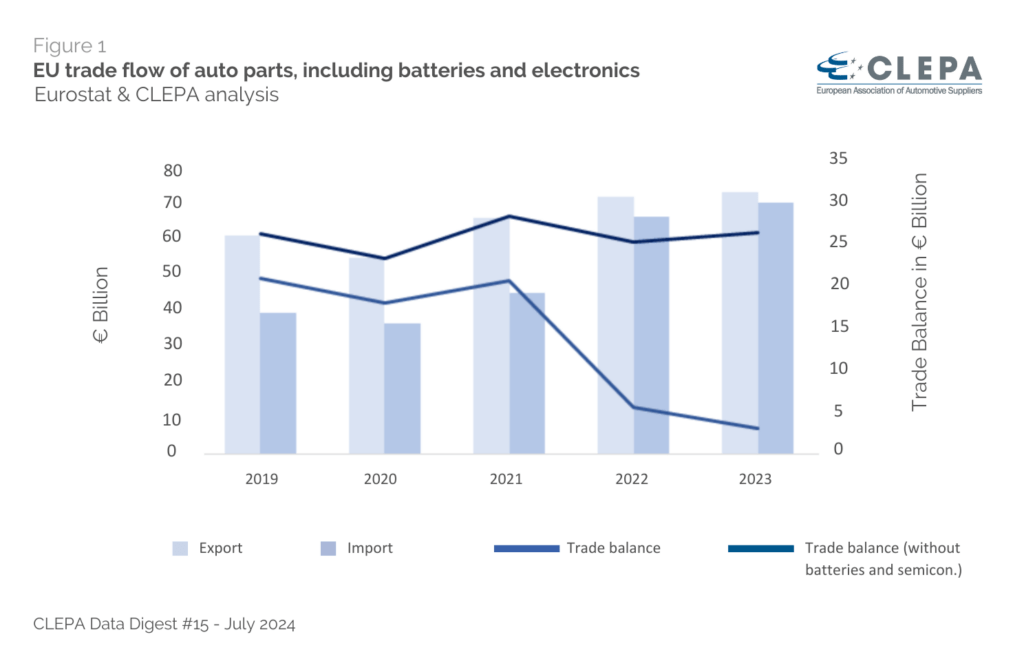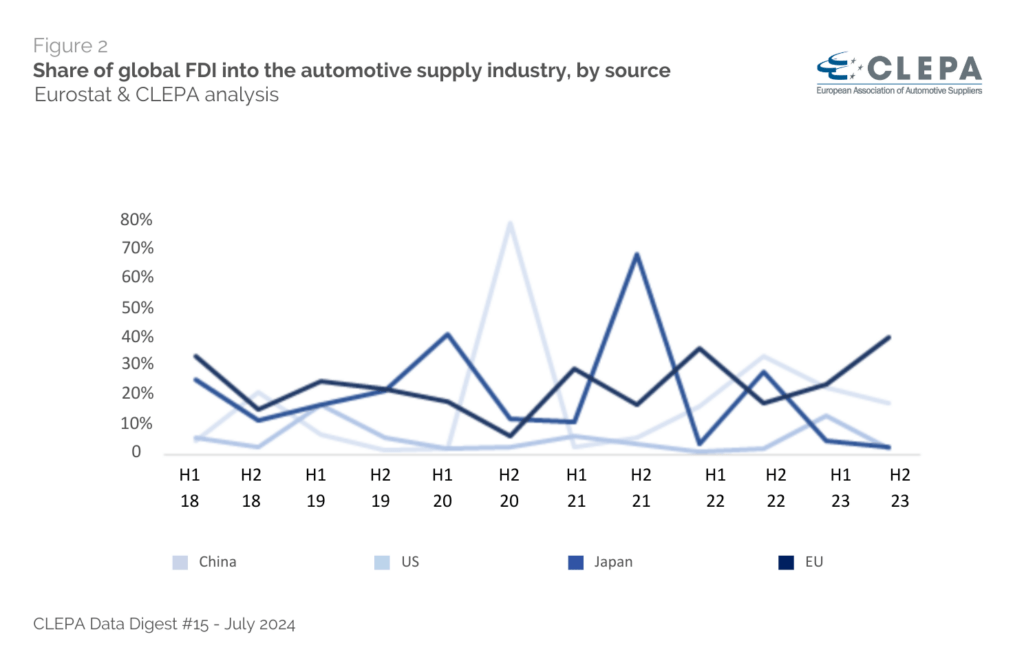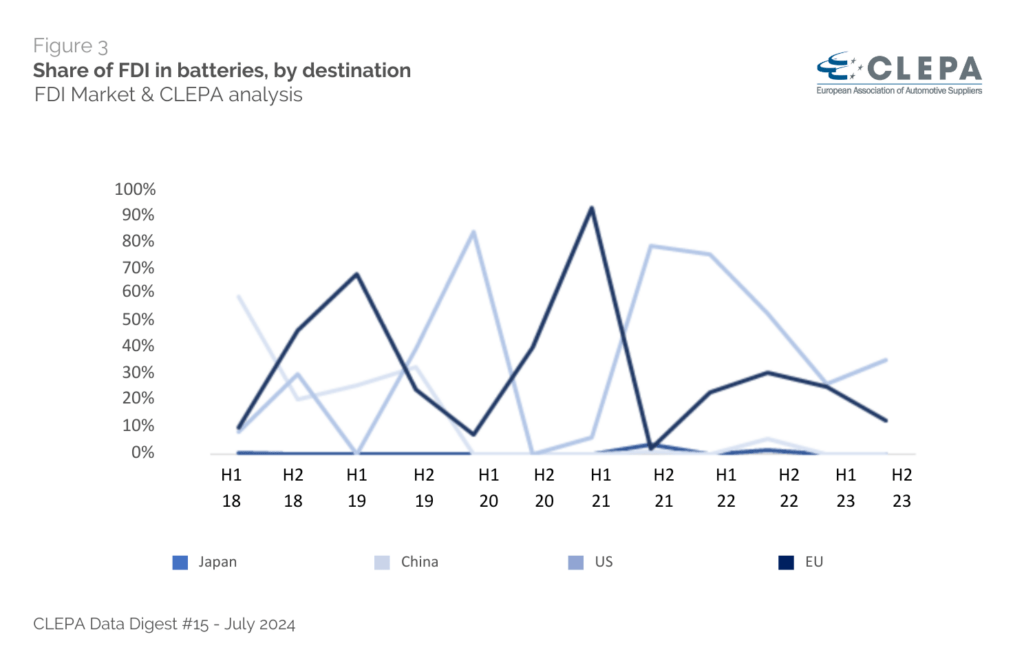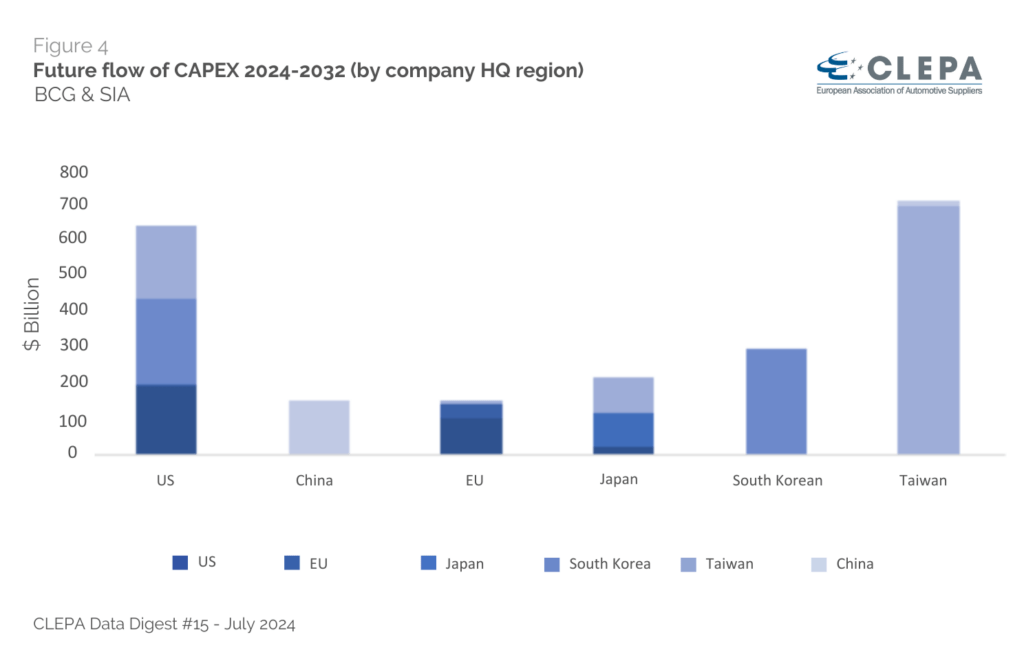EU could face historic shift as automotive trade balance tilts towards deficit

Edition #15 – DATA DIGEST is CLEPA’s bi-monthly publication shedding light on the health and resilience of the European automotive supply industry through latest facts and figures
EU could face historic shift as automotive trade balance tilts towards deficit
The European Union’s (EU) automotive trade balance is at a critical juncture, with the potential to become a net importer of automotive components for the first time ever in 2024.
Despite significant investments in research and development (R&D), the EU’s manufacturing of innovative automotive technologies is increasingly moving abroad. In 2023, the EU automotive supply industry successfully defended its status as the world leader in the export of conventional automotive components, exporting roughly €56 billion and recording a €26.7 billion trade surplus. However, this dominance is being challenged by the growing import of batteries and semiconductors. When including these technologies, the EU’s trade surplus fell from €5.7 billion in 2022 to €3.1 billion in 2023, marking a sharp contrast to the €20.9 billion surplus recorded in 2021.
EU companies continue to dominate global automotive investment in R&D and manufacturing facilities, with European suppliers responsible for roughly a third of all foreign direct investment (FDI) conducted globally. EU companies also lead in automotive-related R&D expenditure, investing significantly and almost matching the US. EU suppliers account for 32.7% of global automotive-related investment, closely following companies headquartered in the US at 33.3%, and outspending Japanese (17.4%) and Chinese (16.4%) competitors by a considerable margin. However, investment in production is increasingly moving abroad, with the US outperforming the EU in investments into battery and semiconductor manufacturing plants.
If the current trends continue, the EU may become a net importer of automotive components this year. This situation underscores the urgent need for the EU to reinforce its competitiveness and ensure that European innovations are primarily manufactured in the EU.
What you will find in this edition
1 – Batteries and semiconductors shift the EU trade balance
2 – EU suppliers invest heavily abroad amid global competition
3 – US continues to attract more battery investment than the EU
4 – Asia and US are top destinations for semiconductor investment
5 – EU dominates global private R&D investment in automotive
The EU’s once impressive trade surplus in components has eroded by €17 billion in the last two years due to rising battery and semiconductor imports. While suppliers continue to dominate R&D and global investment, new technology manufacturing risks moving outside the EU. It is crucial that the EU strengthen its investment strategy to ensure we remain a manufacturing hub.

Nils Poel
CLEPA’s Head of Market Affairs
The EU trade surplus in automotive components, batteries and semiconductors fell from €5.7 billion in 2022 to €3.1 billion in 2023. Over the past two years, the trade surplus has fallen by roughly €17 billion, driven by strong growth in imports of batteries and, to a lesser extent, semiconductors*. Excluding the trade in these two technologies, the EU’s trade surplus in automotive components amounted to €26.7 billion.
If this trend continues, the EU could face a trade deficit as early as 2024. There is some hope for a recovery in the years to come, as battery production grew from 69 GWh in 2022 to nearly 100 GWh in 2023. Optimistic market forecasts suggest that battery cell production could be catching up with demand by 2026. However, more than half of these announced investments are still at risk of not materialising due to uncertainty about demand and enabling conditions.
*Trade in batteries and semiconductors accounts for 93% of battery volume and 37% for semiconductors being used in the automotive sector— Lithium-ion battery capacity to grow steadily to 2030 | S&P Global Market Intelligence (spglobal.com)

European automotive suppliers continue to invest massively abroad, demonstrating the sector’s resilience in the face of global competition. In 2023, they invested €19.8 billion in other regions, making EU suppliers the largest sectoral investors overseas. In 2023, 29.3% of total FDI in automotive components, including batteries and semiconductors, originated from European companies.
North America remains the preferred region for European investment, with the three largest battery investments taking place in Canada. Regarding automotive components, eight of the 10 largest investments are made either in Mexico or the US.
This significant outward investment underscores the global competitiveness of EU suppliers. However, it also highlights the need for the EU to attract more of this investment to ensure the resilience of its automotive supply chain.

Investing in battery production is crucial for reducing dependence on China and strengthening the EU’s position in the global market. Europe has become an attractive destination for FDI in batteries, however, since the second half of 2021, the US has been drawing the majority of these investments, significantly outpacing the EU. The US has secured twice as much FDI in battery production, with €46.3 billion compared to the EU’s €22.4 billion, since 2022. This disparity underscores the urgent need for the EU to bolster its investment strategies and policies to remain competitive.

EU suppliers represent roughly one third of global R&D investment in automotive relevant technologies, but our once strong trade surplus could turn into a deficit this year. It is essential that we enhance our competitiveness in semiconductor manufacturing to secure Europe's position as a leader in innovation and technology.

Benjamin Krieger
CLEPA’s Secretary General
Investment in semiconductors continues to attract global interest, with $2.3 trillion in private sector investment projected for the period between 2024 and 2032. This marks a significant increase compared to the $720 billion mobilised globally between 2013 and 2022.
Of the projected $2.3 trillion, the EU is expected to attract only $154 billion over the next few years, with 66% of this investment coming from American companies and 28% from European firms. Since 2020, eight new semiconductor facility projects have been announced in the EU, with two already completed. While this progress is promising, particularly in comparison to China, it remains modest when juxtaposed with the 26 new plants planned in the US.

European companies continue to lead in R&D investment for the automotive sector, significantly outpacing both China and the US. In 2022, EU companies invested €72.81 billion in vehicles and parts, representing 42.1% of total global automotive R&D investments. If adjacent technologies such as batteries (electrical equipment) and semiconductors are included, the EU share is slightly lower but still significant at 32.7%.
However, this dominance sharply contrasts with the EU’s relatively low private R&D investment in batteries and semiconductors. In the semiconductor sector, US companies account for 62.2% of total R&D expenditure, while the EU contributes just 11.7% of global R&D. Similarly, in electronic and electric equipment, the EU lags behind, with €11.8 billion invested compared to €22.3 billion by Chinese companies. While China appears to be falling behind in semiconductor R&D investment, it benefits from substantial government incentives amounting to $142 billion, compared with €47 billion for Europe and $39 billion for the US.

Are you interested in knowing more?
Contact CLEPA Communications Team at communications@clepa.be



